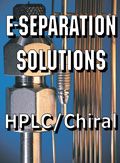Technology Forum: HPLC and Chiral Separations
This month's Technology Forum looks at the topic of HPLC/Chiral and the trends and issues surrounding it. Joining us for this discussion is Magali Curiel of Thar Technologies, Inc., Rich Cowman of JASCO, and Geoffrey Cox of Chiral Technologies.
This month's Technology Forum looks at the topic of HPLC/Chiral and the trends and issues surrounding it. Joining us for this discussion is Magali Curiel of Thar Technologies, Inc., Rich Cowman of JASCO, and Geoffrey Cox of Chiral Technologies.
What trends do you see emerging in HPLC/Chiral?
Curiel:S FC has become a top priority for medium and large pharmaceutical companies for methods development, purification, and analysis. Just as many chromatographers have been drawn towards high speed HPLC with small particle analytical columns, these same analytical chemists will seek SFC as an orthagonal technique running at faster speeds.
Cowman: Racimization studies are becoming essential in the research and development process when a molecular candidate, especially pharmaceuticals, is found to be a chiral molecule. It is possible to perform achiral separations to track racimization and eliminate the need to separate the enantiomers using long runs and expensive Chiral columns.
Cox: Technology breakthroughs to advance faster separations, mainly due to smaller stationary phase particle size and shorter columns, will be the trend. This development focus may not go as far as uPLC, since the mass transfer in chiral separations is often not as rapid as in achiral separations. In addition, there will be an increasing emphasis on the stability of stationary phases. Chiral Technologies, in partnership with our parent company, Daicel Industries,Ltd., is introducing immobilized chiral separation phases, which do not dissolve. These immobilization techniques have allowed preparation of stable stationary phases, which offer new solutions to difficult separation challenges.
Two other areas of growth will be:
a. SFC methods for preparative chiral separations
b. Smaller diameter columns for LC-MS applications
What is the future of HPLC/Chiral?
Curiel:Currently, SFC is only employed in drug discovery for the most part but a couple of major companies are spreading it into early development. The early results of expanded application of SFC are very promising and point towards a future with SFC used as a quality assurance tool.
Cowman: With an increasing number of synthesized candidate compounds of a chiral nature, there is a marked increase for ways to speed up the time to run stability studies. Future time and money savings depend on new separation and analysis methods to speed up the development process.
Cox: Chiral separations will continue to be a growing separation technique, mainly due to the increasing appearance of chiral molecules in drug pipelines, both in analytical and preparative applications. The next few years should see additional drug molecules with chiral chromatography as part of the production scheme.
What is the HPLC/Chiral application area that you see growing thefastest?
Curiel: I see purity analysis and methods development for drug development as the areas that will boom next. Additionally, more and more users are looking to switch from mass-triggered prep HPLC to mass-triggered SFC to reduce solvent waste and dry-down time.
Cowman: Performing racimization studies without a chiral separation using a chiral CD detector. The method of monitoring the ratio of UV response to CD response offers the required information about the chirality of the molecule(s) without the need to separate the enantiomers and is valid regardless of absolute concentration.
Cox: The fastest area of growth will be enantiomeric preparative and semi-preparative separations for most stages of early development, up to and including Phase 1 trials. Advancement here will reduce the time to test, and in the worst case, will allow faster elimination of molecules that will fail without large investment in their syntheses.
What obstacles stand in the way of HPLC/Chiral development?
Curiel: Pharma companies are afraid of the FDA and afraid to change from HPLC to SFC even if SFC is faster and has better resolution. Key SFC champions need to step up to make the analytical chemistry lab a greener and more efficient place.
Cowman: There is a lack of understanding of the process by which the chiral CD detector can aid in racimization studies to save time and money. The use of this detector in conjunction with a chiral separations eliminates the need to buy expensive chiral columns and perform lengthy separations to determine enantiomeric excess.
Cox:One obstacle could be the reluctance of scientists to accept that chiral separations can help them reach their goals more quickly, replacing elegant experimentation and purification research. Another obstacle could be the lack of confidence (“buy-in”) from engineers to accept chiral chromatography as a viable and economic manufacturing process for drug production.
Polysorbate Quantification and Degradation Analysis via LC and Charged Aerosol Detection
April 9th 2025Scientists from ThermoFisher Scientific published a review article in the Journal of Chromatography A that provided an overview of HPLC analysis using charged aerosol detection can help with polysorbate quantification.
Removing Double-Stranded RNA Impurities Using Chromatography
April 8th 2025Researchers from Agency for Science, Technology and Research in Singapore recently published a review article exploring how chromatography can be used to remove double-stranded RNA impurities during mRNA therapeutics production.










